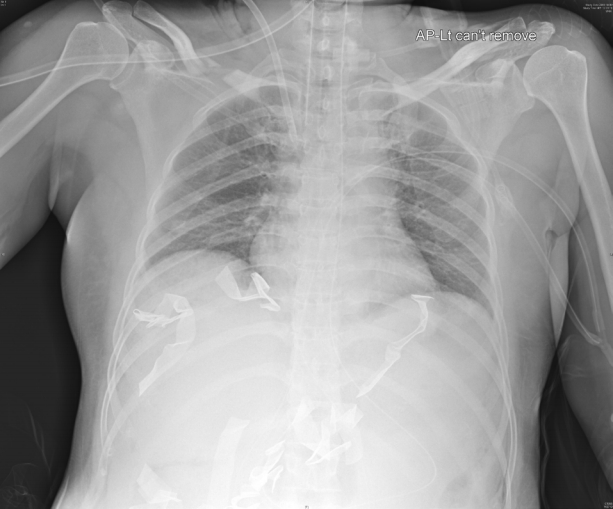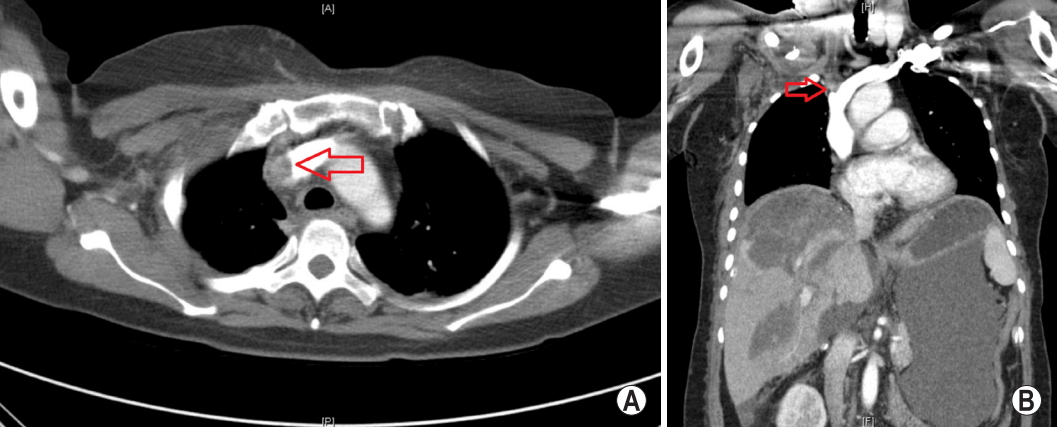Introduction
Central venous catheterization (CVC) is an essential component of critical care. A multilumen access catheter (MAC) is a large-bore catheter used for rapid fluid and blood administration during trauma and resuscitation [1]. However, the complications of using of this catheter are variable and may cause serious problems, even fatal events. Here we reported the cases of a 73-year-old woman and 52-year-old woman with a MAC complication of hemothorax and thrombosis.
Case presentation
Case 1
A 73-year-old woman who suffered a pedestrian traffic accident (TA) was referred to our regional trauma center. Initial examination showed blood pressure (BP) of 80/50 mmHg and pulse rate of 107 beats/min. Because of shock, a MAC insertion was attempted on her left subclavian vein but failed, and thus, CVC on the right subclavian vein was performed. Owing to the suspicion of a hemoperitoneum and pelvic bone fracture, the patient underwent emergency explorative laparotomy. Following splenectomy and preperitoneal pelvic packing, she immediately underwent angioembolization on her left internal iliac artery. A follow up chest x-ray demonstrated a newly developed left hemothorax (Fig. 1). Despite chest tube insertion and postoperative intensive care, the patient died due to uncontrolled hemorrhagic shock.
Case 2
A 52-year-old woman who was involved in a motorcycle TA was transferred from the local hospital to our trauma center after an initial assessment. Initial examination showed BP of 89/49 mmHg and pulse rate of 83 beats/min. Initial image findings included hemoperitoneum due to liver laceration and minimal pneumothorax. Following MAC insertion into her right internal jugular vein, she underwent emergency explorative laparotomy (Fig. 2). The patient underwent additional definitive surgery 1 day after emergency damage control surgery. Moreover, 7 days after the definitive surgery, thrombosis of her right internal jugular vein was detected in a follow-up computed tomography (CT) (Fig. 3). She was discharged with anticoagulation medication after multidisciplinary care with the cardiology and thoracic surgery departments.
Discussion
CVC is a common and valuable procedure for fluid and blood infusion, drug administration, and hemodynamic monitoring in the operating room, emergency room, and intensive care unit. A MAC is a large-bore catheter that prevents kinking or collapsing. It is used for rapid fluid and blood administration during trauma and resuscitation. Additionally, another CVC can be placed through the sheath hub to monitor central venous pressure or to apply additional medication or a fluid line [1]. However, it is an invasive procedure and the incidence of complications ranges from 2% to 26% [2]. Complications include bleeding, hematoma, malpositioning of the catheter, thrombosis, arrhythmia, infection, pneumothorax, and hemothorax [3]. To reduce the occurrence of these complications, it is necessary to limit the use of MAC, or to use ultrasound. In addition, physician experience can affect the incidence of complications [4,5].











